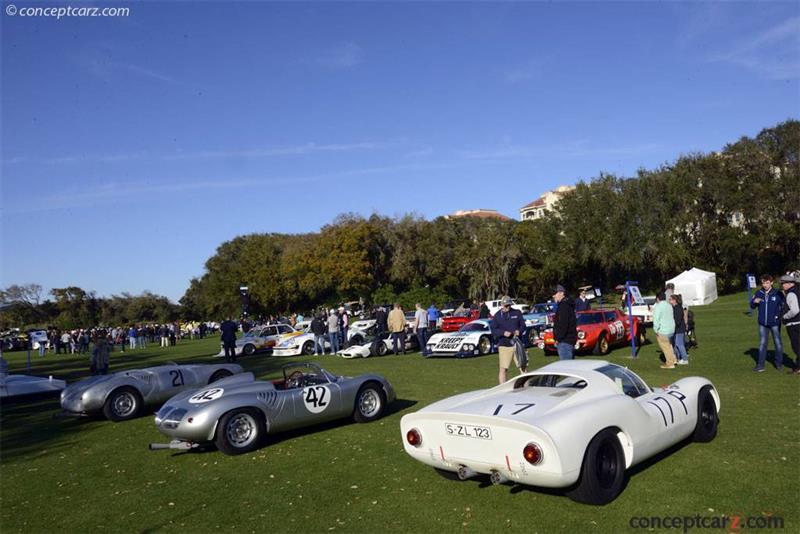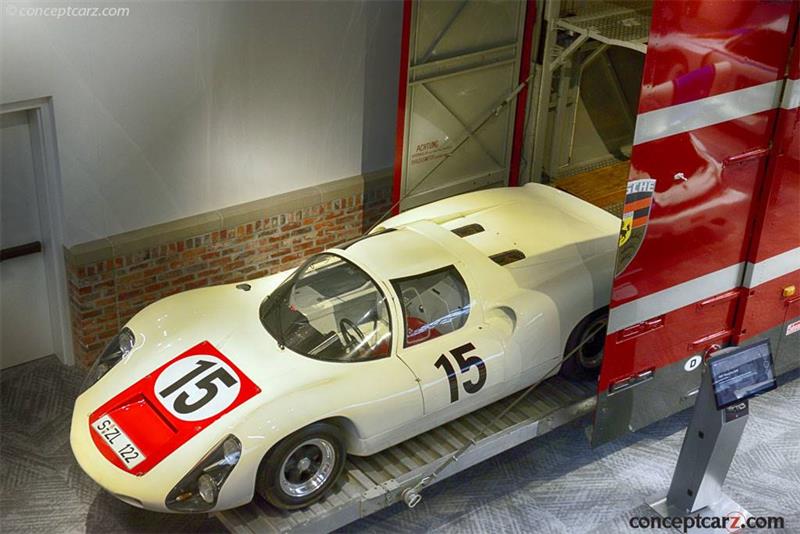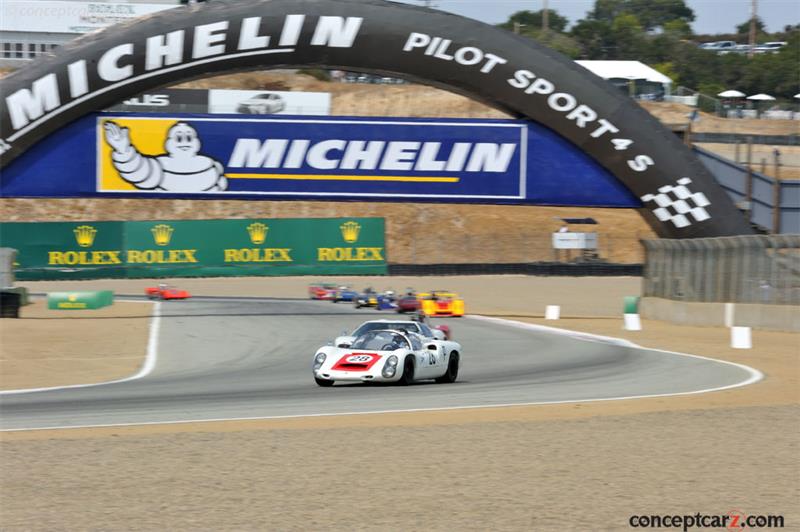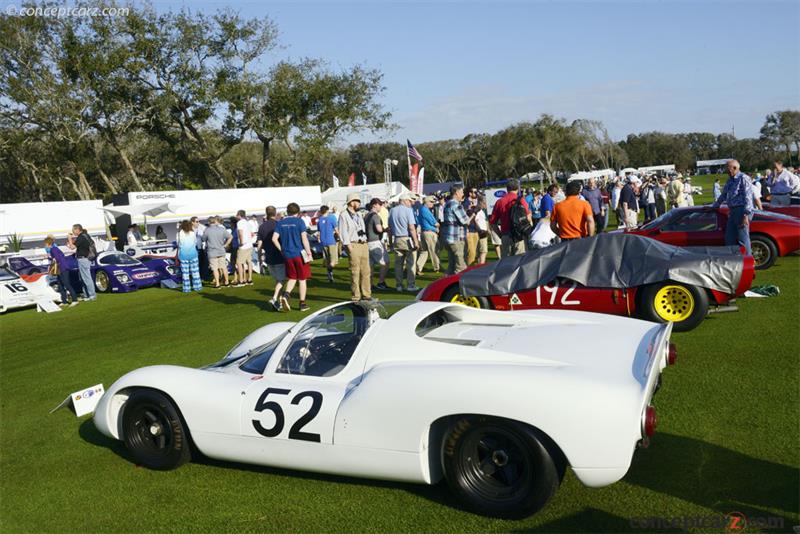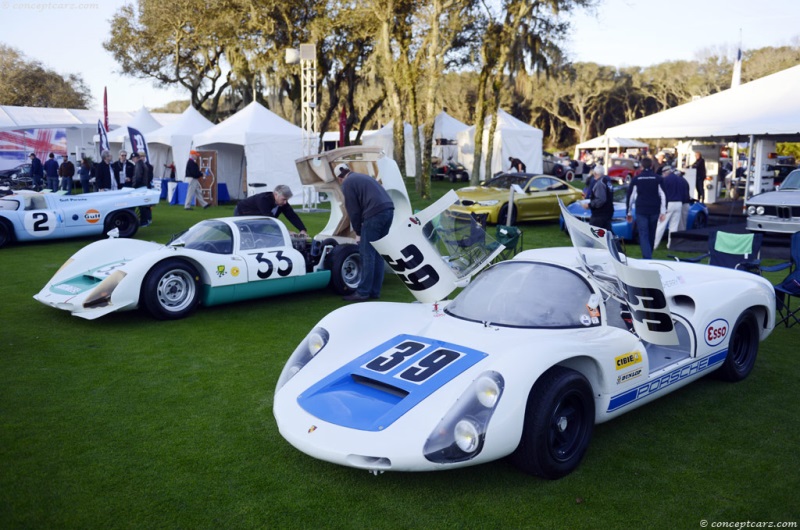The mid-engine Glocker racing specials evolved into the exceptionally sophisticated and well-engineered Porsche 550 which earned racing pedigree and accolades during the 1950s. From the 550 that introduced the world to the Type 547 dual-overhead-cam flat-four engine (renamed the Carrera motor after dominating the Under 1,500 cc Class at the 1953 Carrera Panamericana road race) through the Type 718 RSK, Porsche showed the mettle of German engineering in the face of large-displacement Italian competitors. The final evolution of the Carrera-based racing spyder, the RS 60 and RS 61, competed during the early 1960s. 
Coupe
Chassis #: 910-025
View info and historyDuring the early 1960s, the Porsche flag was flown by the Type 356-based Abarth-Carreras in international GT racing. Porsche decided to end its expensive Formula 1 program at the end of 1962 and once again turned its complete attention to sports car racing. FIA homologation regulations required a minimum of 100 road-usable cars to be built which made the complex spaceframe design of the Type 718 RSKS obsolete. Porsche's Technical Director, Dr. Hans Tomala began work on a new setup, using design inspiration from Colin Chapman's Lotus Elite, which had a fiberglass body/chassis, which had successfully demonstrated the potential of composite materials for structural use in cars. In 1964, Porsche introduced the 904 GTS Coupe, bringing an end to the four-cylinder line. Tomala designed a chassis comprising a pair of steel, cross-braced, box sections, to which the fiberglass bodyshell was bonded. The suspension and engine were bolted directly to the steel structure which reduced noise and vibration - a problem that afflicted the all-composite Elite. Power was from the 356 Carrera 2's Type 587 2.0-liter four-cam, four-cylinder engine. When Ferrari introduced the 206 Dino it made the fiberglass-bodied 904 GTS obsolete. Porsche's response was the Type 906, soon to be known as the Carrera 6, introduced in the mid-1960s. It continued the midship placement for the engine, positioned ahead of the rear transaxle, but unlike the 904 (which had been constructed on a sheet-steel backbone frame, the 906 had a tubular steel space frame with a 90.6-inch wheelbase. The front track measured 52.7 inches and the rear track of 55.2 inches. The suspension was fully independent, with coil springs and wishbones, ZF rack-and-pinion steering, and large four-wheel disc brakes inside the 15-inch steel and alloy disc wheels. Experimental Department head Ferdinand Piech, Ferdinand Porsche's grandson, had hoped to use a 13-inch diameter Formula One wheel to lower the new car's profile, but since the company had already acquired a large quantity of new 15-inch wheels for a planned, but canceled, a second production run of 904s, the larger wheels (and steeply arched front fenders) prevailed. 
Coupe
Chassis #: 910-025
View info and historyPowering the Type 906 was an air/oil-cooled boxer with a lightweight, magnesium alloy, seven-main-bearing case. This setup proved problematic and was later replaced by new factory sand-cast aluminum pieces. The crankshaft was forged steel, and the connecting rods were titanium. The cylinder heads were of aluminum alloy, carrying sodium-filled exhaust valves. The bore measured 80 millimeters and the stroke 66-millimeter, giving it a swept cylinder volume of 1,991 cubic centimeters. With the help of a pair of Weber 46 IDA 3C triple-throat carburetors and a 10.3:1 compression, the engine offered 210 DIN horsepower at 8,000 RPM, and 145 foot-pounds of torque at 6,000 RPM. The engine was backed by a five-speed, fully-synchronized transmission with a variety of gearing options available. Porsche also built nine prototypes with Bosch mechanical fuel injection (known as the 906E) and two more chassis were given flat eight-cylinder engines. The Porsche 910, also known as the Carrera 10, was introduced during the summer of 1966 and raced through 1967, continuing the company's assault on international competition. It was similar to the preceding 906, including the spaceframe chassis, but with suspension, changes to accommodate the smaller 13-inch magnesium wheels. The body featured a Targa roof which eliminated the 'gull-wing' doors fo the 906. The engine continued to be the two-liter, flat-six found in the Type 906. The 906-010 test mule was raced in hill-climb events, with the first road racing debut for the 910 being the Daytona 24 Hours where it finished fourth overall behind the larger engined competition. Two examples were brought to Sebring where they finished third and fourth overall, again behind the much larger engined competition. At the Targa Florio, Porsche entered six cars including a 2.2-liter, flat-eight-cylinder 910. The 2.2-liter Porsche came in first followed by two other six-cylinder Porsches taking second and third. At the Nurburgring, the 910 claimed the top four spots. An eight-cylinder 910 scored another overall victory in the Mugello 500 km later in the year. 
Coupe
Chassis #: 910-006
View info and historyBy the time of the LeMans race, the competitiveness of the 910 had been superseded by the new eight-cylinder engined Porsche 907. The 910s were raced by privateers at LeMans, with all of the 2.2-liter factory cars re-engined with the two-liter flat-six. The competitive lifespan of the Porsche 910 was short, but it was an important developmental step in the company's pursuit of victory at LeMans. It earned outright and dominant victories at the Targa Florio and Nurburgring 1000 Km, and the European Hill Climb Championship in 1966. Compared to the preceding 906, it was faster, lighter, and more 'nimble.'
by Daniel Vaughan | Mar 2020
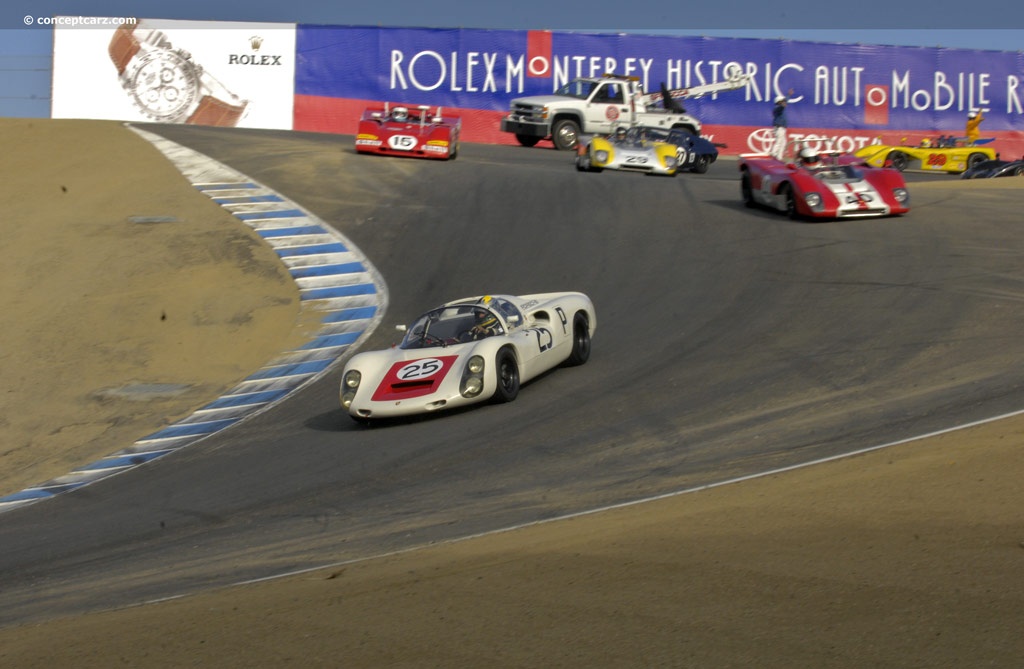
Coupe
Chassis #: 910-025
View info and history
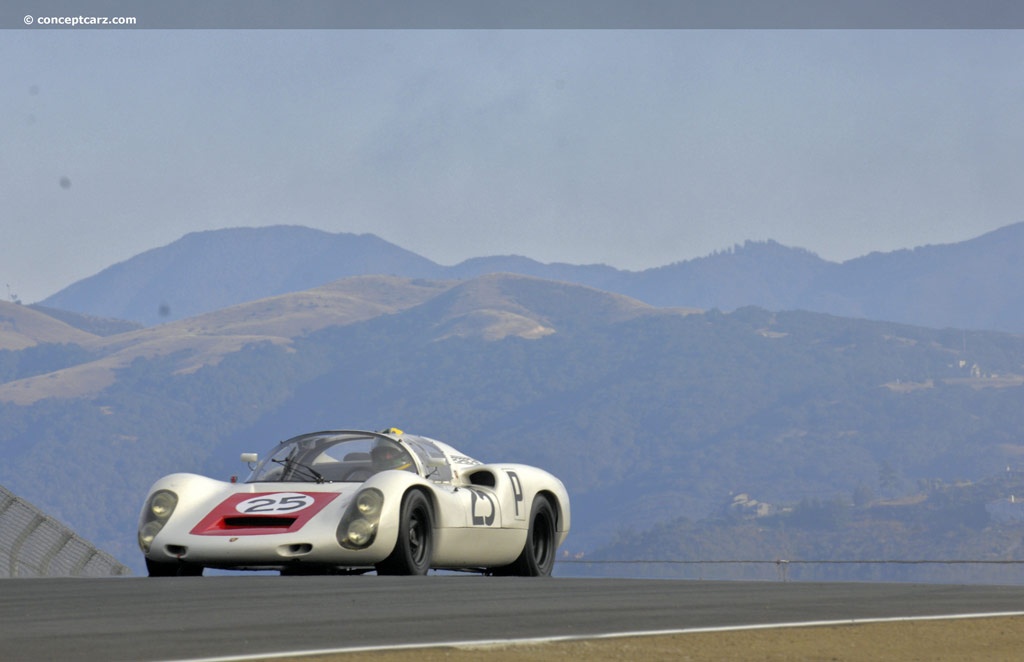
Coupe
Chassis #: 910-025
View info and history
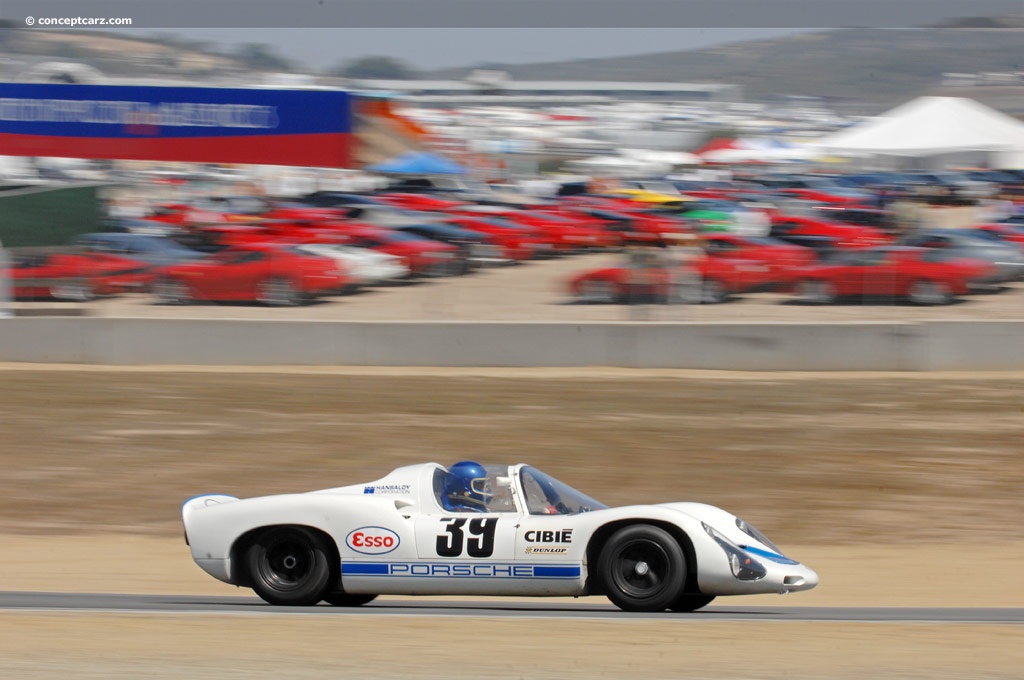
Coupe
Chassis #: 910-006
View info and history
by Daniel Vaughan | Mar 2020
Targa Florio Vehicles
Similar Vehicles
1967 Porsche 910 Vehicle Profiles
Recent Vehicle Additions
Related Automotive News

1968 Targa Florio-Winning Porsche 907 K To Star At Broad Arrow's Inaugural Amelia Auction
Highly authentic works factory prototype powered by its original engine leads Broad Arrows inaugural Amelia Auction on March 4 at the Ritz-Carlton, Amelia Island.
Raced at the 1968 Sebring 12 Hours and the outright winner of the 1968 Targa Flo...

The Brumos Collection
The Brumos Collection, located at 5159 San Pablo Road South, recently opened its doors to the public, with viewings on Thursdays and Fridays from 10 a.m. to 3p.m (and one Saturday a month). Although they rarely use the word museum, the mission...

120 years of motor sport at Mercedes-Benz take centre stage at the Goodwood Festival of Speed 2014
Addicted to Winning at this years Goodwood Festival of Speed, Mercedes-Benz looks back on some fascinating racing victories of the last 120 years
The unique motor sport heritage of the Mercedes-Benz brand is being celebrated with an exclusive i...

Techno Classica 2014: more than 30 racing cars to celebrate 120 years of Mercedes-Benz motor racing history
Cars that were the heroes of magical moments put their stamp on this high-powered, most comprehensive show presentation
With more than 30 vehicles, Mercedes-Benz Classic presents motor racing history in all its unique breadth and depth
120 years o...

1969 24 Hours of Le Mans: A Traditional Statement Provides a Memorable Race
What if a statement ended up costing one of the biggest victories of ones career Would it be worth it Jacky Ickx would come close to finding out as he approached the checkered flag on the afternoon of the 15th of June in 1969.
Ford had determined...






























